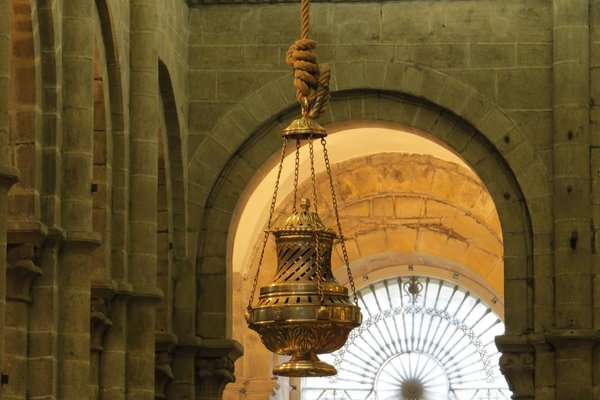Spain
Santiago de Compostela
Santiago de Compostela (Old Town) comprises a major Christian pilgrimage site.
The site dates from the 9th century when the tomb of Apostle Saint James ‘the Greater’ was discovered here. His remains are revered here since and the city was named after him. Thousands of pilgrims from all across Europe walked to this sanctuary. Furthermore, the town’s Romanesque and Baroque monuments have influenced art and architecture in the Iberian peninsula.
Community Perspective: The city seems best appreciated after walking there. The Cathedral is mainly impressive for its size and active pilgrim life.
Site Info
Official Information
- Full Name
- Santiago de Compostela (Old Town) (ID: 347)
- Country
- Spain
- Status
-
Inscribed 1985
Site history
History of Santiago de Compostela
- 1985: Inscribed
- Inscribed
- Type
- Cultural
- Criteria
- i
- ii
- vi
Links
- UNESCO
- whc.unesco.org
- Official
-
- santiagoturismo.com — Monastery and Church of Santa María de Conxo
- santiagoturismo.com — Santiago Turismo
- Related
-
- catedraldesantiago.es — Catedral de Santiago
All Links
UNESCO.org
- whc.unesco.org — whc.unesco.org/
Official Website
- santiagoturismo.com — Monastery and Church of Santa María de Conxo
- santiagoturismo.com — Santiago Turismo
Related Resources
- catedraldesantiago.es — Catedral de Santiago
News Article
- Nov. 6, 2020 smithsonianmag.com — A 12th-Century Mason Created a Hidden Self-Portrait in Famed Spanish Cathedral
- Aug. 8, 2018 metro.co.uk — Hunt for vandal who gave 12th century sculpture a Kiss makeover
- July 7, 2011 guardian.co.uk — Codex Calixtinus manuscript stolen from Santiago de Compostela - Priceless 12-century manuscript, which contains Europe's first travel guide, went missing from a safe in Spanish cathedral
Community Information
- Community Category
- Urban landscape: Medieval European
Travel Information
Exact locations inscribed twice (or more)
Recent Connections
-
European Route of Historic Gardens
Alameda Park (Link)
-
True Cross
"In the Chapel of the Reliquary (...) i…
-
Perfect Inscriptions
1985
Connections of Santiago de Compostela
- Individual People
-
-
Sir Francis Drake
"Curiously, until the 19th c. worshippers could not visit the relics, which in fact had been "missing" since the 16th century. It turns out that they were hidden in 1589 to prevent Sir Francis Drake from stealing them and taking them to England. However, in the end, the "pirate" did not even reach Compostela." -
Charlemagne
"The "Historia Caroli Magni" tells of how "[a]t the request of Saint James who appears to him in dream, Charlemagne embarks on four wars to wrest Spain from the Saracens. In the first war, he takes his army to Santiago de Compostela and conquers all of Spain. (...) Once the last Saracen leaders are defeated, Charlemagne invests Santiago de Compostela with considerable powers and begins the return to France."See en.wikipedia.org
-
- Trivia
-
-
Replica in Mini-Europe
-
Depicted in Mizielinska Maps
CathedralSee i.pinimg.com
-
Built or owned by French
The façade of the Pazo de Raxoi on the Praza do Obradoiro was designed by the French architect Charles Lemaur in the 18th century.See fr.wikipedia.org
-
Hotels in Historic Buildings
Hostal de los Reyes Catolicos -
On Euro coins
Commemorative 2 euro coin Spain 2018. Commemorative 2 euro coin Spain 2018 + The Obradoiro façade of the cathedral, the best known, is depicted on the Spanish euro coins of 1 cent, 2 cents, and 5 cents (€0.01, €0.02, and €0.05). (wiki)See en.wikipedia.org
-
- History
-
-
Located in a Former Capital
Capital of Kingdom of Galicia (410-1833) -
Coronation Locations
"After the centre of Asturian political power moved from Oviedo to León in 910, Compostela became more politically relevant, and several kings of Galicia and of León were acclaimed by the Galician noblemen and crowned and anointed by the local bishop at the cathedral, among them Ordoño IV in 958, Bermudo II in 982, and Alfonso VII in 1111"See en.wikipedia.org
-
Sieges and Battles
In the "10th century and in the first years of the 11th century Viking raiders tried to assault the town (...) and bishop Sisenand II, who was killed in battle against them in 968, ordered the construction of a walled fortress to protect the sacred place.See en.wikipedia.org
-
- Architecture
-
-
Octagons
The cathedral's dome is octagonal: "Hanging from the octagonal dome, opposite the altar, we can see the rope and system of pulleys designed in the 16th century to operate the famous "Botafumeiro" censer." -
Renaissance
Hospital of the Catholic Kings -
Romanesque
Cathedral, Gelmirez Palace and Santa Maria del Sar Church -
Churrigueresque
Facade of the Cathedral -
Plateresque
The Hospital of the Catholic Monarchs -
Baroque
The High Altar reflects the magnificent intervention of baroque architecture in the Romanesque space. (off website) -
Neoclassical architecture
neoclassical façade at Convent and Church of Santo Agostiño -
Gothic
Convent and Church of San Domingos de Bonaval -
Domes
The "dome above the crossing contains the pulley mechanism to swing the "Botafumeiro", which is a famous thurible found in" the Santiago de Compostela Cathedral.See en.wikipedia.org
-
- Damaged
-
-
Thefts since inscription
Codex Calixtinus manuscript stolen from Santiago de Compostela -
Destroyed during invasion
"Taken and laid waste to in 997 by Al Mansour, the city was rebuilt during the 11th century around the apostle's tomb which had gone unviolated." (AB Ev)
-
- World Heritage Process
-
-
Perfect Inscriptions
1985 -
Exact locations inscribed twice (or more)
Also part of 'Route of Santiago de Compostela'
-
- Religion and Belief
-
-
Jesuit Order
Convent and Church of Santo Agostiño is now occupied by Jesuits -
Dominican Order
Convent and Church of San Domingos de Bonaval - said to be founded in 1220 by Santo Domingo de Guzmán -
Benedictines
Monastery and Church of San Martiño Pinario & Monastery and Church of San Paio de Antealtares are former Benedictine monasteriesSee en.wikipedia.org
-
Tombs of Biblical Figures
Traditionally the location of the relics of James, son of Zebedee -
Pilgrimage route
Part of old town area is covered the Camino de Compostela -
Nunneries
Monastery and Church of Santa María de Conxo : "(...) historical documents attribute the foundation to Archbishop Xelmírez, in order to house a community of nuns. (...) The nuns that inhabited it moved to the Monastery of Antealtares in the 15th century." -
Christian Pilgrimage Sites
As part of Route of Santiago de Compostela -
Cathedrals
Santiago de Compostela Cath -
Augustinian Order
Convent and Church of Santo Agostiño (Order of the Calced Augustinians) -
12 Apostles
Traditionally the location of the relics of James, son of Zebedee -
True Cross
"In the Chapel of the Reliquary (...) is a gold crucifix, dated 874, containing an alleged piece of the True Cross." (Wikipedia)
-
Legends and Folk Myths
"According to legend, this tomb [of Saint James] was rediscovered in AD 814 by Pelagius the Hermit, after he witnessed strange lights in the night sky."See en.wikipedia.org
-
Holy Door
Santiago de Compostela Cathedral: "The façade of the cathedral that overlooks the Quintana Square has two gates: the Porta Real (royal gate) and the Porta Santa (holy gate). (...) The so-called Holy Door (Porta Santa) or Door of Forgiveness (Porta do Perdón) is the closest to the steps. It is usually closed with a fence and opened only in Jubilee Years (years when St James's Day, 25 July, falls on a Sunday)."See en.wikipedia.org
-
Mercedarians
Monastery and Church of Santa María de Conxo : After the nuns left in the 15th century, the monastery "was subsequently inhabited by Mercedarian monks." -
Religious Relics
bodies of Saints James, Theodorus and Athanasius
-
- Human Activity
-
-
Invention of sweets and pastries
Tarta de Santiago: "an almond cake or pie". "The first news of the use of this " almond cake ", which we know today as Tarta de Santiago, comes from 1577 during a visit by Pedro de Porto to the University of Santiago... Currently they can be bought in almost all pastry shops in the towns and areas through which the Camino de Santiago passes" (wiki es)See es.wikipedia.org
-
Famous tapestries
The Santiago Cathedral Museum houses "tapestries by Rubens, Teniers, Josédel Castillo or Goya"See museos.xunta.gal
-
- Constructions
-
-
Martyrium
"The excavations conducted in the cathedral during the 19th and 20th centuries uncovered a Roman 'cella memoriae' or martyrium, around which grew a small cemetery in Roman and Suevi times which was later abandoned. This martyrium, which proves the existence of an old Christian holy place, has been sometimes attributed to Priscillian, although without further proof."See en.wikipedia.org
-
Monumental Fountains
Fonte dos Cabalos on the Praza das PrateríasSee gl.wikipedia.org
-
Hospitals
Former Hospital and Church of San Roque, "built to provide health care due to the 16th-century plague epidemics" -
Historic Pharmacies
"The San Martiño drugstore has been documented since the end of the 16th century, always run by a monk from the community. At the beginning he attended to the community and, sporadically, to some poor pilgrim or sick person. But in the middle of the 17th century it was opened to the public and at the beginning of the 19th century it was moved to the left wing of the main façade of the monastery to allow access from outside, in what became known as the new pharmacy."See en.wikipedia.org
-
Clock Tower
Part of the Cathedral:"The Clock Tower, also called Torre da Trindade or, Berenguela, is at the intersection of the Pratarías square and the Quintana square. (...) In 1833 a clock was placed on each side of the tower by Andrés Antelo, commissioned by the Archbishop Rafael de Vélez. As part of its mechanism it has two bells, one, at the hour, called Berenguela, and a smaller one marking the quarter hours."See en.wikipedia.org
-
Famous Bells
The [Clock] tower houses the Cathedral's largest bell, also known as Berenguela. The original from 1678 cracked and was replaced by the current one (...). It is said that if there are ever 13 strokes at midnight instead of 12, the Devil will have an extra magical hour to roam around." -
Equestrian Statues
Inside the Cathedral there is a statue of Saint James Matamoros on his white horse ("an 18th-century work by Jose Gambino") -
Cemeteries
The "descent to the bowels of the Cathedral is really a descent to the history of the sacred hill (...). In these narrow spaces, previously accessible only to researchers, visitors will find a Roman cemetery and Swabian necropolis with dozens of tombs, as well as gravestones from 13 to 19 centuries old." -
Magic Squares
SATORSee es.wikipedia.org
-
Dynastic Burial Places
Cathedral: "The Royal Pantheon displays tombs and reclining statues of kings of Galicia and León that died in the 12th to 14th c.: Fernando II of León, Alfonso IX (VIII of Galicia), the queen Doña Berenguela (wife of Alfonso VII), Doña Juana de Castro (wife of Peter the Cruel) and Raymond of Burgundy, niece of Pope Callixtus II and son-in-law of Alfonso VI, among others."
-
- WHS on Other Lists
-
-
European Route of Historic Gardens
Alameda Park (Link)
-
Memory of the World
The Codex Calixtinus of Santiago de Compostela Cathedral and other medieval copies of the Liber Sancti Jacobi: The Iberian origins of the Jacobian tradition in Europe (2017) -
European Capital of Culture
2000
-
- Timeline
-
-
Built in the 11th century
the cathedral was constructed 1075-1122
-
- WHS Hotspots
- Science and Technology
-
-
Universities
"Santiago is the site of the University of Santiago de Compostela, established in the early 16th century."See en.wikipedia.org
-
Libraries
The Archive-Library of the Cathedral of Santiago de Compostela, "comprising books and documents from the Middle Ages until today; one of the main centers of the world for research on St. James."See en.wikipedia.org
-
- Literature & Film
-
-
Location for a classic movie
"THE MILKY WAY" (BUNUEL/1969) AT THE CATHEDRAL Milky Way / La Voie lactée refers to the Route itself. It is about two pilgrims walking on the Routes in France and Spain to Santiago de Compostela.
-
News
- smithsonianmag.com 11/06/2020
- A 12th-Century Mason Created a Hid…
- metro.co.uk 08/08/2018
- Hunt for vandal who gave 12th cent…
- guardian.co.uk 07/07/2011
- Codex Calixtinus manuscript stolen…
Recent Visitors
Visitors of Santiago de Compostela
- Adam Hancock
- Adolfo
- Adrian Turtschi
- Alberto Rodriguez Gutierrez
- alex
- Alexander Barabanov
- Alexander Lehmann
- alicemears
- Alikander99
- A. Mehmet Haksever
- Ammon Watkins
- Ana Lozano
- Andrew_Kerr
- Anna Wludarska
- Antonio J.
- Argo
- Artur Anuszewski
- Aspasia
- Atila Ege
- AustralLights
- BaziFettehenne
- Bill Maurmann
- Bin
- Bram de Bruin
- Bruno_Pires
- CampbellME
- Catoplayer
- Cezar Grozavu
- cflw
- Cheryl
- chiuliqi
- Christian Wagner
- Christravelblog
- Claire Bradshaw
- Cluckily
- Clyde
- Corinne Vail
- ctravel
- CugelVance
- Dani Cyr
- Daniela Hohmann
- Daniel Chazad
- Danieljbromberg
- Dan Pettigrew
- David Aaronson
- David Berlanda
- del
- Dimitar Krastev
- Dimitrios Polychronopoulos
- Dolemite92
- Don Irwin
- Dorejd
- edstar500
- Elaine McArdle
- Els Slots
- Emilia
- Emili Xaus
- emvcaest
- Eva Kisgyorgy
- Evgenii
- fabi-ddorf
- Fan Yibo
- Farinelli
- Feldhase
- Femke Roos
- Filip Murlak
- Frederik Dawson
- FS
- Garry Jackson
- George Gdanski
- GeorgeIng61
- Gernot
- Grzegorz Andruszkiewicz
- HaraldOest
- Harald T.
- Harry Mitsidis
- H Beswick
- headventure
- Hubert
- Iain Jackson
- Ian Cade
- Igloo
- Ingemar Eriksson
- irosey
- Ivan Rucek
- Jakob F.
- janem
- Janina Lehmann
- janis
- Janos
- Jan-Willem
- Jarek Pokrzywnicki
- Jasam
- Javier
- Javier Coro
- Jay T
- jcleek27
- Jeanne OGrady
- Jens
- Jezza
- João Aender
- Joel on the Road
- Jonas Kremer
- Jonas Martinsson
- Jon Eshuijs
- JoStof
- Joyce van Soest
- JR's HERITAGE SITES
- Jurre
- jxrocky
- kamonpetch
- Karito Vies
- Kbecq
- Kedp2023
- Kevin247
- kjluebke
- Knut
- Krijn
- krtek
- Krzysztof B
- Kurt Lauer
- La Concy
- Lado Joel
- Laetitia Yin
- Lara Adler
- LaVale
- leroykstlj
- lichia
- Little Lauren Travels
- Loic Pedras
- Luboang
- Lucas Del Puppo
- Lucio
- Ludvan
- Luis Filipe Gaspar
- Maciej Gil
- Malgorzata Kopczynska
- marc Rouserez
- Martin
- Martina Rúčková
- Marty
- Mathijs
- MAURO PODDA PANI
- Max
- MaYumin
- MH
- Mia esguerra
- MichaelH
- Michael Novins
- michaelsballard
- Miguel Marquez
- Mikan22
- Mikko
- Mikko Syrjä
- Milan Jirasek
- Ming_9734
- MMM
- Monica Tasciotti
- Morodhi
- Msarmiento1979
- nan
- napalm
- Niall Sclater
- Nihal Ege
- Palimpsesto
- Paola Laura
- Patrik
- Patrik_globe
- Paul Schofield
- Persian Globetrotter
- Petteri
- Philipp Leu
- Philipp Peterer
- Pink Bunny
- Piotr Wasil
- Porcho
- Rafabram
- Randi Thomsen
- Reisedachs
- Remigiusz
- Reza
- Roger Ourset
- Roman Bruehwiler
- Samy G
- Sandmann15
- Schnitzel
- Sclowitz
- scubarrie
- SDMArado
- Sergio Arjona
- Shandos Cleaver
- Shannon O'Donnell
- Shijie ZHU
- sibariam
- Simonf
- Solivagant
- Ssong.x
- Stan
- Stanislaw Warwas
- stephanvermeulen
- Svein Elias
- Szucs Tamas
- Tamara Ratz
- Tammy Gouldstone
- Taotao Chen
- Tarquinio_Superbo
- Tcchang0825
- Tevity
- Thomas Buechler
- Thomas van der Walt
- Tim Allen
- tingmelvin
- travellingcat
- triath
- Truls Brekke
- Tsunami
- usagi1974
- ValiaVeweth
- Vanessa Buechler
- Van Hung
- Vernon Prieto
- Viaje al Patrimonio
- voyager
- Walter
- Wieland
- Wimmy
- Wojciech Fedoruk
- Xander Huang
- Xiong Wei
- Xiquinho Silva
- Yongcheng Liu
- Zoë Sheng
- Zos M
Community Reviews
Show full reviews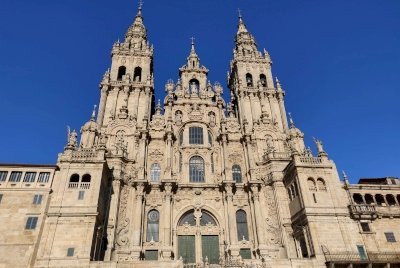
Even if I’m not that religious of a person, Santiago de Compostela still has that mythical sound to it, so a visit of the city and its cathedral was on my to-do list. The town didn’t disappoint. It’s nice to roam around the little streets in the historic centre, to come across little squares and to sit at a table with a drink enjoying the surroundings. Driving around in the city was a bit more stressful, though, and I was happy I had my navigation system with me. Be patient and choose your parking garage beforehand and a back-up in case your first choice is full.
I was staying just outside of Santiago, so I was in town every evening for dinner. For the “real” exploration of the World Heritage, I took out one day. I started my day with a visit of the Santa Maria del Conxo Monastery. Nowadays, it’s a psychiatric hospital, so I didn’t venture inside. I just had a look in the church and the cemetery just next to it.
Most of the rest of my day was centred around the Cathedral. Take your time on the Praza do Obradoiro to take in the magnificent façade and the atmosphere of the square. There will always be groups op pilgrims arriving after their long walk. Although it is the main façade, one does not enter the cathedral via this side. If you want to visit the interior of the cathedral, you have to go to …
Keep reading 0 comments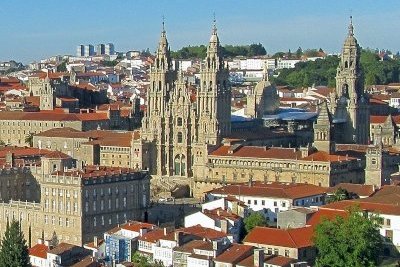
Pilgrim, you have reached journey's end. The paths through the old town suddenly open up onto a plaza marked with walkways in the shape of the scalloped symbol of the Camino de Santiago, and there, at the center of the rays, pilgrims and tourists alike stop in awe and reflection and gaze up at the Baroque façade of the Santiago de Compostela Cathedral. The cathedral is even larger than it seemed when looking down at the bell towers from the Mount of Joy outside the city. Staffs and backpacks are set down and cell phones and selfie sticks are pulled out. Some kiss the ground in reverance. And then, sometime later, the visitors migrate to the side entrance to the cathedral, and file through the nave and around the altar, mostly in hushed silence. The famed incense burner had been set aside and scaffolding was erected throughout the cathedral when I visited in May 2019; the work in preparation for the next Jubilee Year in 2021, when St. James's Day, 25 July, falls on a Sunday. Still, the rich golden altar is an impressive site, and many pilgrims take a moment of silence as they step into the crypt below the altar, where by tradition the relics of St. James are housed. Like life, Santiago de Compostela is not just about the destination, but about the journey, and it is a fascinating place to experience and observe.
Logistics: There's no better way to appreciate the Old Town of Santiago …
Keep reading 0 comments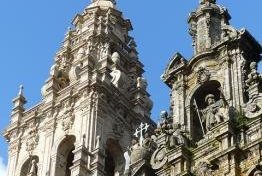
I visited this WHS in May and June 2016 after more than a month walking the Camino Frances. The cathedral in itself is nothing special aesthetically although quite unique as the sculptures of St James dominate the main facades. The main facade and towers are undergoing extensive restoration works but still the cathedral is huge enough to enjoy a slow walk round its exterior. The clock tower houses the cathedral’s largest bell, the Berenguela. It is said that if there are ever 13 strokes at midnight instead of 12, the devil will have an extra magical hour to roam around the dark streets of Galicia's capital. The former pilgrims' hospital, now a parador, has an exquisite facade. Almost every street hides a chapel, a church or a Romanesque, Gothic, Renaissance, Baroque or a Neoclassic building but still in my opinion the old town should not have been inscribed on its own but only as an important part of the Routes to Santiago in Spain. The Alameda park is worth visiting too for a panoramic view of the old town. Obviously this WHS will still have a special place in my heart but more for religious, spiritual and intangible cultural reasons than for its OUV. I'll surely never forget arriving to this place, hugging the kitsch statue of St James, attending mass as a pilgrim like millions of other pilgrims have done before me since the Middle Ages and smelling the incense in the cathedral while the Botafumeiro was swung by …
Keep reading 0 comments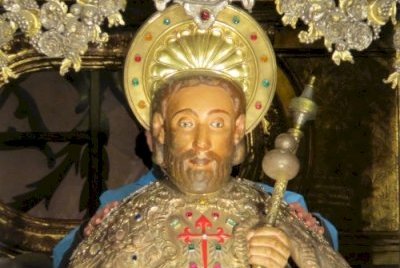
This was my last WHS left ‘to do’ on mainland Spain: the Old Town of Santiago de Compostela. Hidden away in the far west of the country, it’s actually better accessible from Portugal than from the main Spanish airports. I visited the city on a day trip by rental car from Oporto, on Holy Saturday. (I actually wrote ‘Easter Saturday’ at first, but in the English language this seems to be reserved for the Saturday after Easter Sunday).
There’s an hour time difference between Portugal and Spain, so I did not arrive as early as I had wanted. Most of the religious monuments are only open for short hours, with a long lunch break or even no afternoon openings at all. And to make things worse it was raining heavily. I hurried directly to the city’s landmark, the Cathedral. Unfortunately, its main entrance, the Façade of the Obradoiro with the Pórtico da Gloria, is undergoing restoration at the moment. You now have to enter via a side entrance.
The Cathedral is huge and there’s a lot to admire - especially if you’re a lover of over-the-top baroque. For someone like me, not raised with (Iberian) Catholicism, it feels very kitsch. But to those that come here as a pilgrim, it really is their holy site. I saw people praying at several chapels, and lighting candles. I stumbled upon a man in robes inside a wooden box – a fully operational confessional, one of many here. A long queue …
Keep reading 0 comments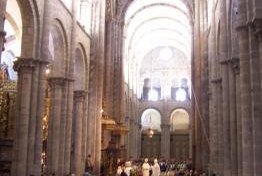
Santiago almost defeated me. It rained heavily and consistently for the 3 days I was there, the times of masses seemed to never correlate with the information I was given, even the Jamon seemed to be a little less tasty. However I still came away with a somewhat grudging but genuine affection for the city.
Whilst the grey Baroque of the Cathedral may not be to everyone's liking (see below) I was impressed by it. I especially liked that it is covered in patches of moss and twigs, which actually add something to the facade. However the original Romanesque Portico de Gloria which is now inside the cathedral is a really impressive sculptural grouping that rewarded repeat viewings. The interior of the cathedral was perhaps not as spectacular as I had thought however entering through the Holy Door to hug the statue of St James, was a fittingly traditional way for me to end my pilgrimage, and also afforded great views of the ornate gold detailing of the Choir. Having attended the Pilgrim's mass in holy year I also managed to see the famous Botafumeiro (incense burner) being swung. There are magnificent views of the cathedral from the park (Caballeira de Santa Susana) just to the west of the centre.
Aside from the cathedral there are networks of charming streets throughout the centre, and a wealth of churches, academic buildings and other grand edifices. It also has the feel of a university city, which always makes a place more appealing …
Keep reading 0 comments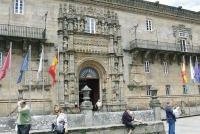
For the town at the focus of the Route of Santiago de Compostela (listed 1993) it came as an anticlimax for me. The town had little of historical or cultural interest besides the cathedral.
Arriving at the railway station the consigna was closed and there was little information on how to reach the cathedral. So I took my luggage on a #6 bus to Praza de Galicia and walked to the cathdral from there. The external staircases are fine and the interior embellishments of the altar and chancel well executed, but not of outstanding universal value.
Keep reading 0 comments
The Pilgrimage to the (supposed) Tomb of Apostle St James the Great at Compostela was of great significance within medieval Europe. Here was one of the world’s first “Tourist journeys” complete with badges, souvenirs and even a guide book! An understanding of those times would be incomplete without an appreciation of the pilgrimage’s place in the medieval consciousness and surely this understanding would be helped by going there oneself?
But I can’t say that we personally were particularly impressed by Santiago. The main Plaza with its Palace, Town Hall and Pilgrims’ Hospice (now a Parador) is certainly enormous/impressive as an ensemble and, in my view, is the “best bit”. But the mainly baroque Cathedral which takes up 1 side of the square is in my eyes a bit ugly (even its much vaunted “Portico de la Gloria” – photo) and its Romanesque interior rather oppressive and overbearing. However, enthusiasts of Baroque, Romanesque and Gothic will no doubt find much to enthuse about and admire. Probably, one’s view of its beauty and significance would be considerably enhanced if backed by the faith which has drawn so many people there over the centuries. The chapels inside containing, as well as the “relics” of the Saint and 2 of his disciples, a “piece of the true cross”, will also be of great importance to some visitors.
Despite my personal misgivings it is clearly still a “must do” European site for its historical importance, its religious significance and its architectural grandeur, whether you possess …
Keep reading 0 comments
